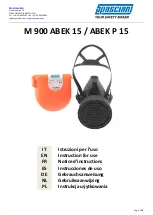
12
4 Installation of sun[e]
4.1 Site selection and installation
Table 4.1.1
Recommendations for installation of pyranometers
Location
The horizon should be as free from obstacles as possible.
Ideally, there should be no objects between the course of the
sun and the instrument.
Mechanical mounting / thermal insulation
Use connection by bolts to the bottom plate of the instrument.
A pyranometer is sensitive to thermal shocks. Do not mount
the instrument with the body in direct thermal contact to the
mounting plate (so always use the levelling feet also if the
mounting is not horizontal), do not mount the instrument on
objects that become very hot (black coated metal plates).
Instrument mounting with 2 bolts
2 x M5 bolt at 46 x 10
-3
m centre to centre distance on north-
south axis, connection from below under the bottom plate of
the instrument.
Instrument mounting with one bolt
1 x M6 bolt at the centre of the instrument, connection from
below under the bottom plate of the instrument.
Performing a representative measurement
The pyranometer measures the solar radiation in the plane of
the sensor. Some installations require a tilted or inverted
position. The sensor bottom plate, parallel to the black sensor
surface, should be mounted parallel to the plane of interest.
in case a pyranometer is not mounted horizontally or in case
the horizon is obstructed, the representativeness of the
location becomes an important element of the measurement.
See the chapter on uncertainty evaluation.
Levelling
In case of horizontal mounting, use the bubble level and
levelling feet. The bubble level is visible and can be inspected
at all times.
Tilted installation
For tilted installation, the tilt sensor provides a sufficiently
accurate measurement. The register “tilt angle” can be used
when mounting and levelling the sensor.
Instrument orientation
by convention: with the cable exit pointing to the nearest pole,
so the cable exit should point north in the northern
hemisphere, south in the southern hemisphere.
Installation height
in case of inverted installation, WMO recommends a distance
of 1.5 m between soil surface and sensor (reducing the effect
of shadows and in order to obtain good spatial averaging).

![Предварительный просмотр 1 страницы Lambrecht sun[e] 00.16130.501030 Manual](http://thumbs.mh-extra.com/thumbs/lambrecht/sun-e-00-16130-501030/sun-e-00-16130-501030_manual_671567-01.webp)
![Предварительный просмотр 2 страницы Lambrecht sun[e] 00.16130.501030 Manual](http://thumbs.mh-extra.com/thumbs/lambrecht/sun-e-00-16130-501030/sun-e-00-16130-501030_manual_671567-02.webp)
![Предварительный просмотр 3 страницы Lambrecht sun[e] 00.16130.501030 Manual](http://thumbs.mh-extra.com/thumbs/lambrecht/sun-e-00-16130-501030/sun-e-00-16130-501030_manual_671567-03.webp)
![Предварительный просмотр 4 страницы Lambrecht sun[e] 00.16130.501030 Manual](http://thumbs.mh-extra.com/thumbs/lambrecht/sun-e-00-16130-501030/sun-e-00-16130-501030_manual_671567-04.webp)
![Предварительный просмотр 5 страницы Lambrecht sun[e] 00.16130.501030 Manual](http://thumbs.mh-extra.com/thumbs/lambrecht/sun-e-00-16130-501030/sun-e-00-16130-501030_manual_671567-05.webp)
![Предварительный просмотр 6 страницы Lambrecht sun[e] 00.16130.501030 Manual](http://thumbs.mh-extra.com/thumbs/lambrecht/sun-e-00-16130-501030/sun-e-00-16130-501030_manual_671567-06.webp)
![Предварительный просмотр 7 страницы Lambrecht sun[e] 00.16130.501030 Manual](http://thumbs.mh-extra.com/thumbs/lambrecht/sun-e-00-16130-501030/sun-e-00-16130-501030_manual_671567-07.webp)
![Предварительный просмотр 8 страницы Lambrecht sun[e] 00.16130.501030 Manual](http://thumbs.mh-extra.com/thumbs/lambrecht/sun-e-00-16130-501030/sun-e-00-16130-501030_manual_671567-08.webp)
![Предварительный просмотр 9 страницы Lambrecht sun[e] 00.16130.501030 Manual](http://thumbs.mh-extra.com/thumbs/lambrecht/sun-e-00-16130-501030/sun-e-00-16130-501030_manual_671567-09.webp)
![Предварительный просмотр 10 страницы Lambrecht sun[e] 00.16130.501030 Manual](http://thumbs.mh-extra.com/thumbs/lambrecht/sun-e-00-16130-501030/sun-e-00-16130-501030_manual_671567-10.webp)
![Предварительный просмотр 11 страницы Lambrecht sun[e] 00.16130.501030 Manual](http://thumbs.mh-extra.com/thumbs/lambrecht/sun-e-00-16130-501030/sun-e-00-16130-501030_manual_671567-11.webp)
![Предварительный просмотр 12 страницы Lambrecht sun[e] 00.16130.501030 Manual](http://thumbs.mh-extra.com/thumbs/lambrecht/sun-e-00-16130-501030/sun-e-00-16130-501030_manual_671567-12.webp)
![Предварительный просмотр 13 страницы Lambrecht sun[e] 00.16130.501030 Manual](http://thumbs.mh-extra.com/thumbs/lambrecht/sun-e-00-16130-501030/sun-e-00-16130-501030_manual_671567-13.webp)
![Предварительный просмотр 14 страницы Lambrecht sun[e] 00.16130.501030 Manual](http://thumbs.mh-extra.com/thumbs/lambrecht/sun-e-00-16130-501030/sun-e-00-16130-501030_manual_671567-14.webp)
![Предварительный просмотр 15 страницы Lambrecht sun[e] 00.16130.501030 Manual](http://thumbs.mh-extra.com/thumbs/lambrecht/sun-e-00-16130-501030/sun-e-00-16130-501030_manual_671567-15.webp)
![Предварительный просмотр 16 страницы Lambrecht sun[e] 00.16130.501030 Manual](http://thumbs.mh-extra.com/thumbs/lambrecht/sun-e-00-16130-501030/sun-e-00-16130-501030_manual_671567-16.webp)
![Предварительный просмотр 17 страницы Lambrecht sun[e] 00.16130.501030 Manual](http://thumbs.mh-extra.com/thumbs/lambrecht/sun-e-00-16130-501030/sun-e-00-16130-501030_manual_671567-17.webp)
![Предварительный просмотр 18 страницы Lambrecht sun[e] 00.16130.501030 Manual](http://thumbs.mh-extra.com/thumbs/lambrecht/sun-e-00-16130-501030/sun-e-00-16130-501030_manual_671567-18.webp)
![Предварительный просмотр 19 страницы Lambrecht sun[e] 00.16130.501030 Manual](http://thumbs.mh-extra.com/thumbs/lambrecht/sun-e-00-16130-501030/sun-e-00-16130-501030_manual_671567-19.webp)
![Предварительный просмотр 20 страницы Lambrecht sun[e] 00.16130.501030 Manual](http://thumbs.mh-extra.com/thumbs/lambrecht/sun-e-00-16130-501030/sun-e-00-16130-501030_manual_671567-20.webp)
![Предварительный просмотр 21 страницы Lambrecht sun[e] 00.16130.501030 Manual](http://thumbs.mh-extra.com/thumbs/lambrecht/sun-e-00-16130-501030/sun-e-00-16130-501030_manual_671567-21.webp)
![Предварительный просмотр 22 страницы Lambrecht sun[e] 00.16130.501030 Manual](http://thumbs.mh-extra.com/thumbs/lambrecht/sun-e-00-16130-501030/sun-e-00-16130-501030_manual_671567-22.webp)
![Предварительный просмотр 23 страницы Lambrecht sun[e] 00.16130.501030 Manual](http://thumbs.mh-extra.com/thumbs/lambrecht/sun-e-00-16130-501030/sun-e-00-16130-501030_manual_671567-23.webp)
![Предварительный просмотр 24 страницы Lambrecht sun[e] 00.16130.501030 Manual](http://thumbs.mh-extra.com/thumbs/lambrecht/sun-e-00-16130-501030/sun-e-00-16130-501030_manual_671567-24.webp)
![Предварительный просмотр 25 страницы Lambrecht sun[e] 00.16130.501030 Manual](http://thumbs.mh-extra.com/thumbs/lambrecht/sun-e-00-16130-501030/sun-e-00-16130-501030_manual_671567-25.webp)
![Предварительный просмотр 26 страницы Lambrecht sun[e] 00.16130.501030 Manual](http://thumbs.mh-extra.com/thumbs/lambrecht/sun-e-00-16130-501030/sun-e-00-16130-501030_manual_671567-26.webp)

















